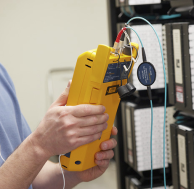Cabling Mistakes #8: Using BIMMF Test Cords and Common Mandrel
March 10, 2016 / General, 101 learning, Installation and testing, Upgrading and troubleshooting, Best Practices
While the smart people who install, test and certify network cabling plants know the importance of meeting standards performance parameters and ensuring application support, even the best of us can make mistakes that adversely impact the bottom line and customer satisfaction.
Let’s take a look at the #8 Dumb Thing that smart people do when testing network cabling systems— Using BIMMF (Bend Insensitive Multimode Fiber) test cords and a common mandrel.
Eliminating Unwanted Modes
Multimode fiber can support hundreds of modes. These modes are categorized into lower order modes that travel a shorter distance closer to the fiber core and higher order modes that bounce back and form from between the core-cladding boundary and therefore travel a longer distance. As you can imagine, these unstable higher order modes are much more susceptible to bending losses.
Unlike lasers used in today's high speed fiber network that concentrate light in the center of the fiber core, the recommended LED light source used in testing tends to overfill a fiber, exciting both the lower order and the higher order modes. So why are LED recommended for testing? The underfilled launch of a laser can overlook high loss events such as a misaligned connection, resulting in an overly optimistic lower loss measurement and the potential for a bad link to PASS. Standards bodies therefore long ago determined that an overfilled launch (i.e., LED) with pessimistic results is the better option.
 Unfortunately, exciting all the modes with an LED source also ends up with wide variations in the measurement--as much as 0.1dB on every connection. While that variation wasn't as much of a concern when dealing with 1 and 10 Gig links, a 0.1dB variance per connection could mean the difference between PASS and FAIL in today's advanced 40 and 100 Gig fiber links with much more stringent loss requirements.
Unfortunately, exciting all the modes with an LED source also ends up with wide variations in the measurement--as much as 0.1dB on every connection. While that variation wasn't as much of a concern when dealing with 1 and 10 Gig links, a 0.1dB variance per connection could mean the difference between PASS and FAIL in today's advanced 40 and 100 Gig fiber links with much more stringent loss requirements.
Controlling launch conditions so that the light source excites primarily the relatively stable lower order modes and removes the higher order modes improves accuracy. One of the early and simplest methods to do this was the use of a common mandrel. When a launch cable is tightly bent around the mandrel, the higher order modes that are more susceptible to this bending are removed so that only low order modes emanate from the launch cable. Sounds like a good idea, right? Well not so much anymore--especially when using BIMMF test cords!
While the mandrel does a good job of removing unwanted modes, it still is not accurate enough for testing today's high speed fiber links. That's why we now have the Encircled Flux (EF) method that more precisely launches the light to better match the laser launch condition of the transceiver (Click here to learn more about encircled flux).
If you do still use a mandrel, beware of your test reference cords. Because test reference cords are not cheap, some may choose to use normal cords. But normal cords are often made from bend insensitive multimode fiber (BIMMF). And if you use BIMMF test cords in conjunction with a mandrel, you are certainly asking for trouble. Why?
BIMMF was introduced to withstand tighter bends with substantially less signal loss, which is critical in high speed fiber applications where the strict loss budgets leave little margin for bend-induced loss due to installation. With BIMMF, a common 25mm mandrel therefore does not strip out the higher order modes at the 850nm wavelength. While a smaller, specially designed mandrel might do the trick with a BIMMF test reference cord, you can't use that same mandrel at the 1300nm wavelength--you will likely find that your link passes at 1300nm but fails at 850.
Problem Solved
The answer is an easy one. Don't use BIMMF for test cords at all--even when testing a BIMMF link. To find out more about the ins and outs of testing BIMMF, download the white paper here.
And it's time to put away that mandrel and use the latest EF method of testing. Not only is EF a more accurate method of testing, it also required by industry standards for testing of today's fiber links.
An even easier way to ensure accuracy? Fluke Network's CertiFiber® Pro Optical Loss Test Set which is encircled flux compliant out of the box and comes with EF non-BIMMF test reference cords. Problem solved.






